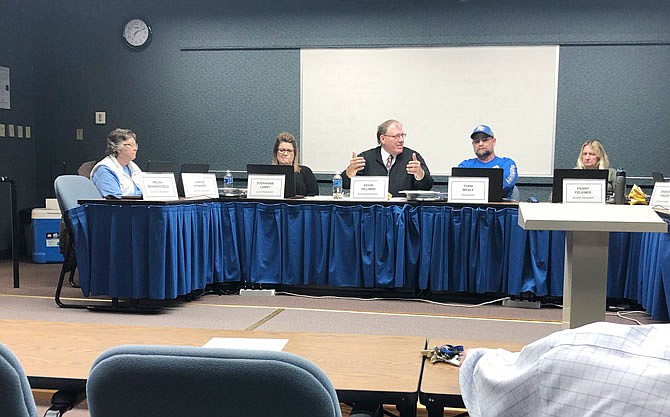South Callaway R-2's administration has a plan for students' return to class this fall.
In fact, they've got a Plan A, B, C and D, Superintendent Kevin Hillman said during Wednesday night's meeting.
"Our intent is to go back to classes Aug. 24," he said. "If our choice gets taken away from us - we're planning for the worst and hoping for the best."
Plan A is a return to business more or less as usual - with all students and teachers asked to return to in-person classes. Safety measures will still be in place, though, including Plexiglas sneeze barriers in the offices, advanced cleaning schedules and switching out water fountains for water bottle filling stations.
"Some other districts and attorneys are talking about how they might even have waivers to attend school," Hillman said.
The district has already acquired small no-contact thermometers to take students' temperatures and may also purchase a larger infrared thermometer meant to hand a high volume of passersby. The contraption combines a digital infrared thermometer with a camera, and if it detects someone with a fever, it'll snap their picture and send it to someone monitoring the system.
Hillman said he'd hate to waste district money if such extreme measures proved unnecessary, but many of the supplies will need to be ordered now to arrive in time for the start of school.
He acknowledged some teachers might not feel safe coming to school if the district returns to in-person classes, and some parents might choose to keep their children at home.
"If it's Plan A, and a handful of kids say they're not coming to school they'd be expected to be Zoomed into classes," he said.
Those students would be graded to the same standard as those attending in-person classes, he added.
Plans B and C tackle scenarios in which the district is asked to limit the number of students on campus each day.
If the district is limited to 50 percent capacity, students might attend every other day. Plan C deals with a similar scenario but with 25 percent capacity.
"If we're restricted to 6-foot social distancing and 25 percent capacity, that's an A.M. school, a P.M. school, an A day and a B day," Hillman said. "If we start going through the demands of that and what that looks like, that's tough."
With limited time in the classrooms, the students will likely lag behind in the curriculum, he said.
"If we get into a deal where it's Plan C, those curriculum schedules, you can throw them out the window," Hillman said. "We don't know how long will this be, what kind of holes it'll cause."
Transporting students would be the real challenge, he said. Members of the same household can ride together safely but must be spaced apart from children from other households. In a best-case scenario, the district could fit 25-30 children in a bus. But a bus full of only children could only fit about a dozen while still complying with social distancing requirements.
"We may have to put it out to parents that they have to drive their kids to school and pick them up afterwards," board member Janice Howard said.
Under Plan D, all students and teachers would stay home and continue distance learning.
"The fundamental difference is, we're moving from a crisis response to a planned scenario," said Mary Van Orden, the district's director of curriculum and instruction.
Hillman said the district saw a high level of participation and engagement from at-home learners after the shutdown in March.
"It was remarkable, what our staff did," Hillman said. "Our percentages were so high."
Hillman said students were graded for their work during the fourth quarter, and that incentivized participation. (However, as long as a student had passing grades when the school shut down, they automatically advanced to the next grade level - no students were kept back for failing to complete classwork during distance learning.)
Plan D calls for students to be graded for their work.
Van Orden said teachers are already preparing lessons that can be delivered online or in-person, as needed.
"The big phrase is location-free learning," she said. "Whatever a teacher sets up in the classroom, it can be delivered (either virtually or in-person), and we're going to grade it in the same way and with the same vigor."
In fact, snow days might soon be a thing of the past - they may become distance learning days.
The primary challenge with Plan D is equal access. Hillman said about 90 percent of district families have high-speed internet access. However, some larger families may lack the bandwidth and devices to support multiple, simultaneous, hours-long Zoom calls.
Board member Penny Felkner noted people can call in to Zoom even if they don't have access to a laptop with a webcam and video call capability. However, Hillman pointed out, those students would be at a disadvantage if the teacher was sharing his or her screen.
The district would also have to work with the families of special-needs students to meet the terms of their Individualized Education Program or 504 plan.
Another complicating factor: During the last few months, many parents in the district have been furloughed or working from home, but by August, many will likely have returned to work.
"They won't want to leave their third-grader at home on Zoom all day," Howard said.
Hillman added the district would be releasing more information to parents as the Department of Elementary and Secondary Education clarifies its requirements and advice to schools.
"The things we've been asked to do, they're probably going to change on us," he said.

